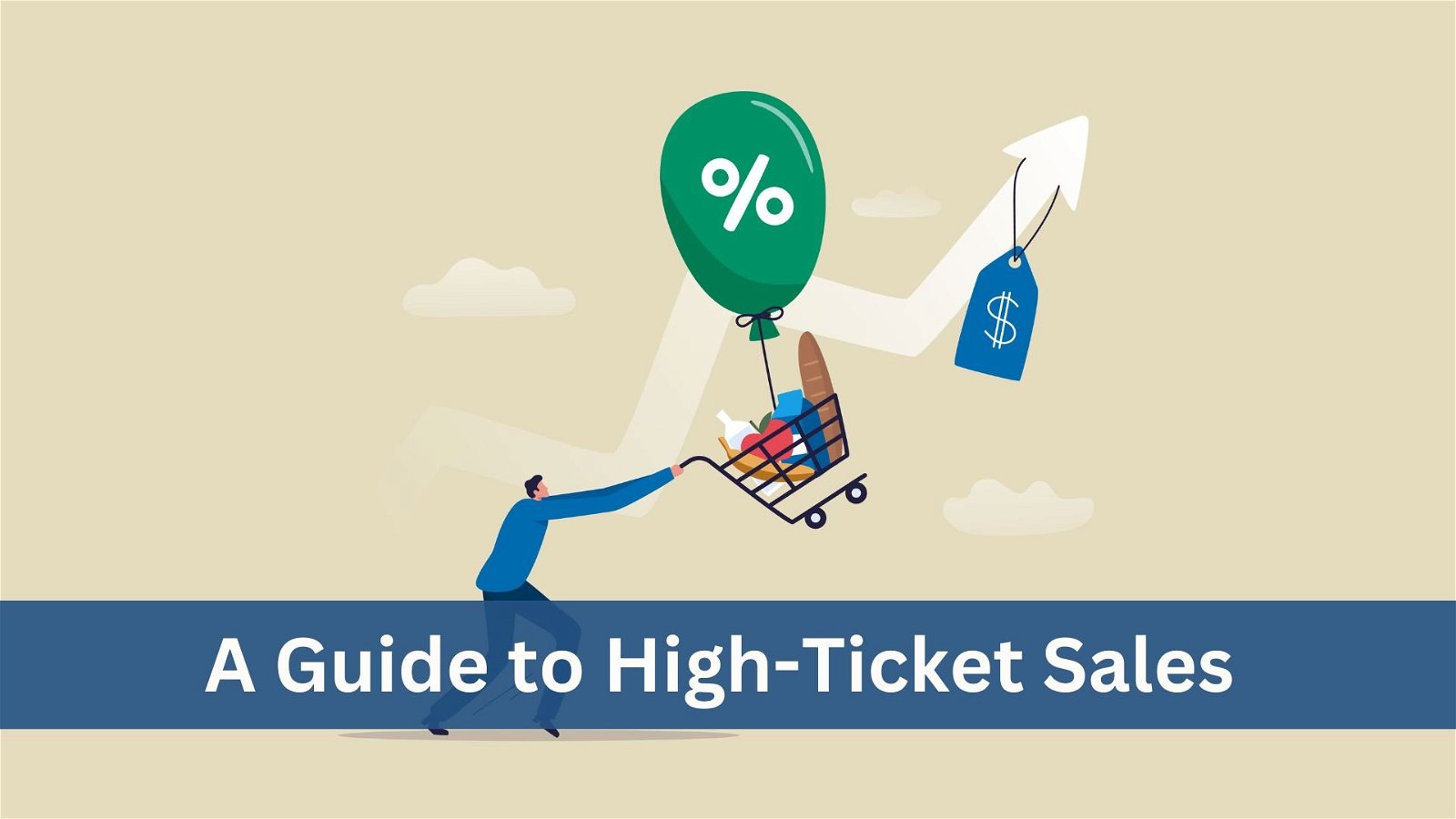High-ticket sales play a pivotal role in the success and sustainability of a business, representing a strategic shift towards a premium model that focuses on quality over quantity. Unlike lower-priced products or services, high ticket items command a premium value, reflecting a deeper level of expertise, customization, and often a more extensive client experience. For businesses, securing high ticket sales can lead to increased revenue with fewer transactions, allowing for a more personalized and intensive approach to customer service. This approach not only fosters stronger client relationships but also positions the business as an authority in its industry.
Table of Contents
ToggleDefinition of High Ticket Sales
High-ticket sales refer to the process of selling premium-priced products or services that carry a substantial monetary value. Unlike lower-priced items, high-ticket sales involve transactions with a significantly higher financial commitment. The term “high-ticket” is subjective and can vary across industries, but generally, it denotes products or services that are at the upper end of the price spectrum within a particular market. High-ticket sales often require a more consultative and personalized approach, as they typically involve a more complex buying decision and necessitate a deeper level of customer engagement. Businesses focusing on high-ticket sales aim to deliver superior value, expertise, and a premium customer experience to justify the elevated price point.
Here are a few steps to sell your high ticket Products
1. Understanding High-Ticket Buyers
Understanding high-ticket buyers is essential for businesses aiming to successfully navigate the landscape of premium-priced products or services. High-ticket buyers typically exhibit distinct characteristics and behaviors that set them apart from the average consumer. These buyers are often more discerning, placing a premium on quality, exclusivity, and a personalized experience.
Key aspects of understanding high-ticket buyers include:
Value Perception: High-ticket buyers seek value beyond the product or service itself. They are willing to invest in premium offerings that provide exceptional quality, unique features, and a superior overall experience.
Relationship Focus: Building strong, personal relationships is crucial with high-ticket buyers. They appreciate a consultative approach, personalized communication, and a deep understanding of their specific needs and preferences.
Research-Oriented: High-ticket buyers tend to conduct thorough research before making a purchase. They seek detailed information, reviews, and testimonials to ensure they are making an informed decision.
Brand Reputation: Brand reputation and credibility play a significant role in the decision-making process for high-ticket buyers. They are more likely to choose products or services from reputable and well-established brands.
Customization and Flexibility: High-ticket buyers often value customization and flexibility. They may have specific requirements or preferences, and businesses that can accommodate these individual needs are more likely to attract and retain such customers.
Long-Term Perspective: High-ticket buyers are often interested in long-term relationships with brands. They may become repeat customers if they perceive consistent value, reliability, and a commitment to excellence.
Exceptional Customer Service: Outstanding customer service is a key factor in attracting and retaining high-ticket buyers. Prompt responses, personalized support, and a focus on customer satisfaction are critical.
By understanding these aspects, businesses can tailor their marketing, sales, and customer service strategies to resonate with high-ticket buyers. This approach not only helps in acquiring such customers but also in building lasting relationships that contribute to the success and reputation of the business.
2. Building a High-Ticket Offer

Crafting a High-Ticket Offer: Elevate your business with a step-by-step guide on creating irresistible, high-value propositions that command top dollar. Explore strategies for packaging, pricing, and positioning your products or services to captivate your target audience and unlock the realm of high ticket sales. This comprehensive resource will empower you to design offers that not only meet but exceed the expectations of discerning customers, propelling your business to new heights of success. Get ready to redefine your value and transform your offerings into lucrative opportunities.
Creating Value Proposition
To develop a compelling high-ticket offer, it is crucial to create a value proposition that communicates the unique benefits and value your product or service brings to your target audience. Start by identifying the key pain points or challenges your potential customers face and tailor your value proposition to address those specific needs. Highlight the distinctive features, advantages, and outcomes that set your high-ticket offer apart from competitors. Clearly articulate how your solution solves a problem or fulfills a desire for your customers, making it a must-have investment.
Packaging and Positioning
Once you have a solid value proposition, focus on packaging and positioning your high-ticket offer in a way that enhances its perceived value. Consider the overall presentation, branding, and messaging to ensure consistency with your target market’s expectations. Develop a strong brand identity that aligns with the premium nature of your high-ticket offer. Position your product or service as a premium solution, emphasizing exclusivity, quality, and the unique benefits it provides. Pay attention to the details of your packaging, marketing materials, and online presence to create a cohesive and compelling image that resonates with your high-end clientele.
Pricing Strategies for High Ticket Sales
When setting the price for your high-ticket offer, it’s essential to carefully consider the perceived value, market demand, and competitive landscape. Avoid underpricing, as this may diminish the perceived value of your offer. Instead, justify the higher price point by highlighting the premium features, exceptional quality, and unique benefits that come with your product or service. Consider offering payment plans or financing options to make the purchase more accessible for your customers. Additionally, incorporate value-added elements, such as exclusive bonuses or premium customer support, to reinforce the value of the high-ticket investment.
Unique Selling Proposition (USP)
A strong Unique Selling Proposition (USP) is vital for differentiating your high-ticket offer in a crowded market. Clearly articulate what sets your product or service apart from competitors and why potential customers should choose your offer over alternatives. Emphasize the exclusive features, specialized expertise, or unique methodologies that distinguish your high-ticket offer. Your USP should resonate with the desires and pain points of your target audience, creating a compelling reason for them to invest in your premium solution. Consistently communicate your USP across all marketing channels to build a strong and memorable brand identity in the minds of your potential customers.
3. Establishing Credibility and Trust

Establishing credibility and trust is paramount in any business, especially when promoting high-ticket offers. To build a solid foundation of trust with your audience, it’s essential to showcase your expertise, reliability, and transparency. Begin by emphasizing your credentials, qualifications, and relevant experience in your industry. Highlight success stories, testimonials, or case studies from satisfied customers who have benefited from your high-ticket offer. Consistently deliver on promises and commitments, demonstrating reliability and dependability.
Establishing credibility and trust is paramount in any business, especially when promoting high-ticket offers. To build a solid foundation of trust with your audience, it’s essential to showcase your expertise, reliability, and transparency. Begin by emphasizing your credentials, qualifications, and relevant experience in your industry. Highlight success stories, testimonials, or case studies from satisfied customers who have benefited from your high-ticket offer. Consistently deliver on promises and commitments, demonstrating reliability and dependability.
Also Read: Monetize Your Facebook Group With These 9 Simple Ways
4. Effective Communication Strategies
Effective communication is essential for success in any context. Tailor your message to your audience, ensuring clarity and avoiding unnecessary complexity. Actively listen, engage in two-way dialogue, and be mindful of timing and non-verbal cues. Utilize various communication channels and remain adaptable to feedback. By employing these strategies, you can enhance the impact of your communication and build stronger connections.
5. Developing a Strategic Sales Funnel
A high-ticket sales funnel guides your ideal customer or member through a sequence of stages, gradually narrowing down the audience until you present a compelling offer to those who successfully progress through the process.
Developing a strategic sales funnel is crucial for guiding potential customers through a structured journey that ultimately leads to conversions.
A. Lead Generation for High-Ticket Sales
Initiate the strategic sales funnel by implementing effective lead-generation strategies tailored for high-ticket sales. Employ targeted marketing efforts, leveraging channels such as social media, content marketing, and lead magnets to attract potential customers with a genuine interest in your premium offerings.
B. Qualifying Leads Effectively
Once leads are generated, focus on qualifying them to ensure they align with your ideal customer profile. Implement robust criteria to assess factors like budget, needs, and decision-making authority. By refining your lead pool, you can prioritize resources and efforts on prospects more likely to convert into high ticket sales, optimizing your overall sales efficiency.
C. Nurturing Prospects through the Sales Funnel
Guide qualified leads through a nurturing process designed to build trust, provide valuable information, and address their specific needs. Utilize personalized content, targeted email campaigns, and engagement tactics to keep prospects engaged and gradually move them towards a deeper understanding of the value your high-ticket offer provides.
D. Closing High-Ticket Deals
Capitalize on the momentum created throughout the sales funnel by employing effective closing strategies for high-ticket deals. Communicate the unique value proposition, address any remaining concerns, and offer customized solutions to meet the individual needs of your prospects. Streamline the closing process to make it seamless and compelling, ensuring a successful transition from prospect to valued customer.
A well-designed sales funnel not only attracts and converts customers but also nurtures long-term relationships, contributing to the sustained success of your high-ticket offers.
6. Providing Exceptional Customer Experience
Providing an exceptional customer experience extends far beyond the point of sale, encompassing a holistic approach to customer satisfaction and loyalty. After closing high-ticket deals, prioritize:
- Post-Sale Follow-Up and Support
- Managing Expectations
- Building Long-Term Relationships
- Encouraging Referrals from High-Ticket Clients
In prioritizing these elements of customer experience, you not only fulfill the immediate needs of your clients but also cultivate a loyal customer base that can be a valuable asset to your business over the long term.
7. Analyzing Sales Performance Metrics

Analyzing sales performance metrics is a critical aspect of optimizing business strategies and ensuring sustained growth. By closely monitoring key performance indicators (KPIs) such as conversion rates, lead generation effectiveness, and revenue trends, businesses can gain valuable insights into the effectiveness of their sales efforts. Understanding the nuances of these metrics allows for data-driven decision-making, enabling organizations to identify strengths, address weaknesses, and make informed adjustments to their sales strategies. Tracking customer acquisition costs, sales cycle length, and customer retention rates provides a comprehensive view of the overall sales performance.
Also Read: How To Create A Facebook Landing Page In 7 Easy Steps
Wrapping Up the Guide to High Ticket Sales
Mastering the art of high-ticket sales requires a strategic and multifaceted approach. From defining what constitutes a high-ticket sale to crafting compelling value propositions, building trust, and implementing effective communication and sales funnel strategies, each step plays a crucial role in achieving success. Understanding the unique characteristics of high-ticket buyers, creating irresistible offers, and providing exceptional customer experiences contribute to not only immediate conversions but also long-term relationships and business growth.
Furthermore, analyzing sales performance metrics serves as a compass, guiding businesses toward continuous improvement and informed decision-making. By incorporating these elements into your high ticket sales strategy, you position your business to thrive in a competitive market and establish a reputation for delivering premium products or services.
Interesting Reads:
Marketing 101: How to Reach Your Target Audience and Grow Your Business
What IS Sales Funnel And How To Create A Sales Funnel For Your Business
Setting the Foundation for Your Online Business: 6 Expert Tips and Strategic Insights








